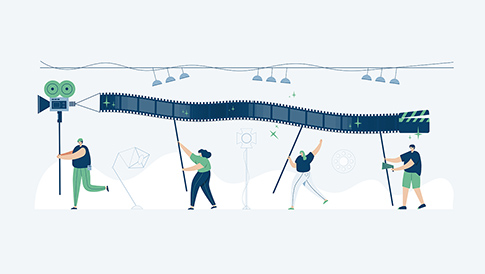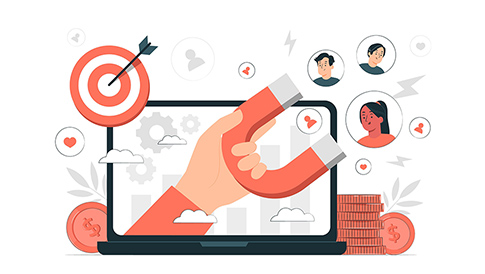16 Powerful Neuromarketing Examples
Neuromarketing has been taking the world of business by storm, yet not everyone understands how to use it. So, what is neuromarketing? To put it simply, it’s a market research method that uses special techniques to provide insight into consumer actions and decisions and create better marketing tactics. At first glance, that definition may be confusing. But as you move foreword through this article, you will start understanding neuromarketing better. Here, you’ll find specific neuromarketing examples explaining how this technique is applied.

How to Use Neuromarketing – Illustrative Neuromarketing Examples
To understand how neuromarketing influences consumers, we’ll have a look at the variety of ways to apply it. Also, you’ll see particular neuromarketing examples for each method application.
Use Color for Evoking Emotions
You probably already know that color can be very effective when used right. Believe it or not, but this is an example of neuromarketing. The color you use in your brand logo or product packaging influences the way consumers perceive them.
For example, cold blue tones are associated with professionalism. Bright colors, obviously, scream attention while the neutral ones are more passive. If you really want to experience the true power of neuromarketing, you need to carefully study color combination guides. As a result, you will know what influence each color has, so you can start using colors properly.
Manipulate Attention with Eye Gaze
This is one of those neuromarketing examples that you probably already know. It’s a fact that ads containing people and especially infants are usually more effective than those that do not have them. According to a study, there’s actually more to it than just the effectiveness of ads.
Firstly, image and video ads with babies tend to make people pay closer attention and be more focused when looking at the ad. However, simply including close-ups of baby faces is not as useful as using yet another technique.
Researches found that when a baby or a person in the ad is looking in a certain direction, viewers will also look there. So, if you want your viewers to pay attention to a product, make sure that the person in your ad is looking at that product. It’s simple.
Attract Customers with Packaging – Neuromarketing Examples
Packaging has always played a crucial role in attracting customers. It’s not always what is inside that counts and advertisers know that and have used that for ages. Consequently, neuromarketing takes this to a whole new level.
Numerous studies have shown what consumers actually like and dislike about packaging. In one such experiment, participants were shown packaging and then their responses were recorded. The survey would regard the answers as positive, negative, or neutral. The surveyed were also asked about colors, text, and images.
One of the results was that many people had a negative impression of shiny packaging while there was no such impression of matte packaging. Logically, some companies like Frito-Lay decided to get rid of shiny packaging.
Measure Satisfaction Levels
One of the lesser-known neuromarketing examples includes ERA or Emotion Response Analysis. By using EEG imaging, ERA can identify the emotions a person has in response to a product, advertisement, etc.
For advertisers, it is extremely important to understand our emotional engagement or arousal related to the product. For instance, if you know that consumers experience frustration as a response to your product, then there is clearly something about your offer that you need to change.
Similarly, it is possible to measure customer satisfaction with EEG. A study related to dermatological treatment found that consumer impressions were directly linked to activation in the neural circuits involved in the assessment of facial beauty.
Ensure the Success of Your Campaign with Effective Ads
One of the best traits of neuromarketing is that it combines two things that seemed to be completely unrelated before – brain imaging and marketing. With the help of fMRI imaging, advertisers have gained the ability to get more insight into human behavior, consumer habits, and more.
For example, it is somewhat of a common practice now to compare advertising campaigns before releasing them to the public. There is usually more activity in a certain part of the brain that leads to viewers reacting to your ads such as calling your hotline or visiting your website.
By looking at which of your campaigns creates more activity in that part of the brain, you can determine the most potentially effective strategy you prepared. Just like EEG, fMRI can help create more engaging marketing campaigns that encourage action among viewers. Nowadays, such methods are becoming more common during the planning stage of the campaign.
Benefit from Decision Paralysis
It is not often that neuromarketing examples prove something that is contrary to popular belief, but such cases do exist. For example, the situation with decision paralysis. You may be surprised by what you hear next.
Columbia University conducted a study that revealed that having too many choices may actually paralyze or even stir away customers. If they see too many similar products standing on a shelf side by side, they will be less likely to stop and choose something.
What you can conclude from this is that less is more and too many choices can be overwhelming. It is essential to understand the difference between variety and too much variety and use neuromarketing to your advantage.
Create Urgency and Speed – Neuromarketing Examples
You probably already know about creating urgency in order to make consumers purchase your product. When there is a limited number of items or they are available for a limited amount of time, people are afraid of missing out and they decide to buy the product. But there is also another use for speed and urgency.
While some companies focus on providing security, PayPal decided to go in a different direction and focus on efficiency and speed. The company conducted a study and found out that convenience activated the brain more than security did. Logically, they started advertising the speed in their payment system rather than any other quality.
Sometimes it is better to focus on such characteristics of your product like speed and efficiency instead of security and safety. Consumers value comfort and convenience more than anything. But there is another aspect that is important, and it is the price.
Be Reasonable with Your Pricing
Among the mentioned neuromarketing techniques you could say that it is one of the less obvious ones and you will be right. Recent studies have shown that .99 pricing is not as effective as advertisers believe it to be.
For starters, rounded figures work best when emotional decision making is involved while complex figures are more useful when the logical part of the brain is engaged. One of the explanations to this is that complex numbers make the brain work more convincing it that the complex price is the more logical choice.
Of course, taking the neuromarketing approach to pricing is now believed to be the better route. This is why you can stick to it too.
Improve Customer Commitment with Anchoring
Neuromarketing research has revealed fantastical things and one of them is anchoring. This is the belief that consumers tend to focus on the first piece of information they get so it is very important for advertisers to get it right.
This information can then be the basis for the person’s purchasing behavior and decisions. There is a flaw in our minds that makes us evaluate things not based on their actual worth but by comparing them to the surrounding options.
Marketers use this “anchoring effect” is to make us commit to something that seems better than everything else (especially true for bundle comparisons you see online). For example, if you are comparing two coffee machines at the same price and one of them has a minor extra feature, you will be more likely to choose the one with the extra feature.
Ensure the Great UX with Website Layout – Neuromarketing Examples
The layout of your website directly influences the performance of your website. Neuromarketing can help you understand what’s best for you. From translating your website to other languages with the help of web translation services like The Word Point to choosing the right color palette – neuromarketing takes everything into account.
Such things as layouts and font sizes are also important. The user-friendly webpage layout is essential for customers. However, the overall interface can have even a bigger impact. For instance, horizontal designs are less effective than vertical ones. The reason is that reading pages from up to down makes users more engaged and keeps them scrolling. Let’s have a look at some successful pages on the example of MotoCMS website templates:


Use Loss Aversion Directly Related to Creating Urgency
As mentioned before, urgency is a big thing and companies using neuromarketing have been utilizing the “buy before it’s gone” strategy for quite a while now. People don’t want to miss out. They are just as worried about gaining as they are about losing.
If you emphasize the fact that consumers are likely to lose something if they don’t buy your product, they will be more open to making a purchase. Of course, your customers may get tired of such advertising as well. So, don’t overuse this technique.
Prevent Miscommunication with Hidden Responses
Sometimes the reality is not what it seems to be and the truth is hiding somewhere beneath the surface. To understand what this means, let’s look at the example with Cheetos that conducted a survey for one of their ad campaigns and used EEG to evaluate consumer responses.
The ad shown to participants had a woman playing a prank on her friend by filling a white load of her laundry with orange Cheetos. The focus groups said they didn’t like the ad. However, the EEG experiment with the same people revealed that they actually did.
It turned out that people held back their opinions about finding the ad humorous in fear of contempt from others. Neuromarketing can reveal our hidden preferences and responses that we may not even be aware of.
Test Prototypes – Neuromarketing Examples
Another great point from the ranks of neuromarketing examples is prototype testing. While advertising plays a crucial role in influencing the way consumers perceive your product, its design is important too. This is when prototypes are truly helpful.
A while ago there was a famous survey conducted by Hyundai that aimed to test the company’s car prototypes. The case used EEG and measured brain activity in response to various design features. As a result, Hyundai opted for changing the interior design of their cars completely.
Such experiments can help understand which stimulation in the brain will most likely result in the person buying your product. It may sound like something out of a sci-fi novel, but it’s our reality now.
Capture Attention with Headlines
Headlines are perhaps one of the most important elements of any ads. In the best tradition of neuromarketing examples, advertisers have turned to such findings in order to better understand which headlines work and which don’t.
There is now a popular technique being used called the “Hippocampal Headlines”. What this means is that when you slightly alter a common phrase, you activate the hippocampus in the brains of the viewers and catch their attention.
For example, you can take the phrase “practice makes perfect” and change it to “practice makes Patron” (like many bloggers have done). So, you will be able to attract the attention of your audience almost instantly.

Involve Social Media as a Very Powerful Tool
Yet another great point from the neuromarketing examples is using this method on social media. It has long been known that social media marketing can be highly effective when done right. Thus, companies that have used neuromarketing on such platforms have proved as much.
In fact, emotional connections can be more influential than customer satisfaction in some cases. Social media is the perfect place for establishing an emotional connection with your audience. Airbnb, for instance, used this when they entered the New York market and put out an emotional video of Carol Williams.
Apply Reward and Punishment
You may think that this is one of the harshest neuromarketing examples. However, it is actually not as bad as it seems at first glance. Game design companies and game developers have been using this tactic for ages and you didn’t even realize it.
Nowadays, games usually have a reward and a punishment for different actions the players complete. By increasing the reward, you can also increase the level of dopamine in the brains of the players. So, you’ll keep them coming back. This technique works for other products too, so it’s not only the game industry that can benefit from it.
Final Thoughts – Neuromarketing Examples and Techniques
All in all, these neuromarketing examples should be enough to give you an idea of what this method is and how you can use it. Integrate neuromarketing into your advertising campaign to get better results from it.





Leave a Reply